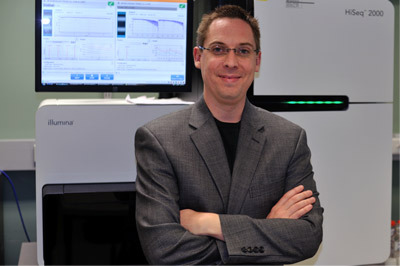Mystery disease solved by gene experts
A global team of researchers has identified the gene behind an Australian toddler’s paediatric brain disorder in a discovery that is paving the way for the diagnosis and treatment of other children with genetic diseases.
The team, led by Dr Ryan Taft from The University of Queensland’s Institute for Molecular Bioscience (IMB), used genome sequencing to determine that three-year-old Massimo Damiani is suffering from a congenital disease previously unknown to medicine.
“We analysed the genome sequences of Massimo and his parents using a method called whole genome sequencing and found that a mutation in the DARS gene was likely causing his disorder,” Dr Taft said.
“In collaboration with clinicians from the Netherlands, Australia and the US, we then examined the genomes of nine other children who appeared to be suffering from the same disease and the genomes of their parents, and confirmed that they all had mutations in the DARS gene.
“This gene has never previously been associated with human disease and may not have been identified as the culprit using any other method.”
The team, comprising experts from the IMB in Brisbane, VU University Medical Center in Amsterdam, Murdoch Childrens Research Institute and The Royal Children’s Hospital in Melbourne, and Children’s National Medical Center in Washington DC, has published their findings in the American Journal of Human Genetics.
They have named the disease HBSL because it causes Hypomyelination in the brain stem and spinal cord, leading to leg spasticity. Hypomyelination occurs when people do not have enough myelin, the substance that coats nerve fibres and enables the transmission of electrical impulses in the nervous system.
“This is the future of medicine - doctors, including clinical specialists like MRI experts, and genomics researchers working together to diagnose and develop treatments for people with unknown diseases,” Dr Taft said.
Dr Taft’s work was supported by next-generation sequencing technology company Illumina.
“The ability to perform highly accurate whole genome sequencing was critical in this discovery, with our sequencers enabling Dr Taft’s team to quickly and cost-effectively scan the entire genome for mutations,” said Christian Henry, Senior Vice President and General Manager of Illumina’s Genomic Solutions business.

Massimo’s father, Stephen Damiani, who worked with the team, said the breakthrough came as a relief.
“Since his sudden developmental regression soon after his first birthday, we have worked tirelessly to achieve a specific genetic diagnosis,” he said.
“Initially, all doctors could tell us was that he was suffering from a leukodystrophy, a group of diseases that cause developmental delays and often premature death, of which 50% remain undiagnosed.
“Soon we ran out of tests but without knowing exactly what was causing Massimo's illness, we could not begin to devise a treatment.
“Discovering the cause of his disorder is a critical step forward to ultimately developing a therapy for him and hopefully many other children with rare genetic conditions.”
The team hope their work will be used as a model for other clinicians and researchers who are faced with unknown diseases. Indeed, Dr Taft and colleagues have already used genomics to identify the genetic mutation responsible for another leukodystrophy, H-ABC. This study was published in the same issue of the American Journal of Human Genetics.
“Our goal is to dramatically reduce the number of unresolved paediatric cases of rare genetic disease,” Dr Taft said.
It is estimated that rare diseases, 80% of which are genetic in origin, collectively affect about half a million Australians.
Blood test could be used to diagnose Parkinson's earlier
Researchers have developed a new method that requires only a blood draw, offering a non-invasive...
Cord blood test could predict a baby's risk of type 2 diabetes
By analysing the DNA in cord blood from babies born to mothers with gestational diabetes,...
DNA analysis device built with a basic 3D printer
The Do-It-Yourself Nucleic Acid Fluorometer, or DIYNAFLUOR, is a portable device that measures...





